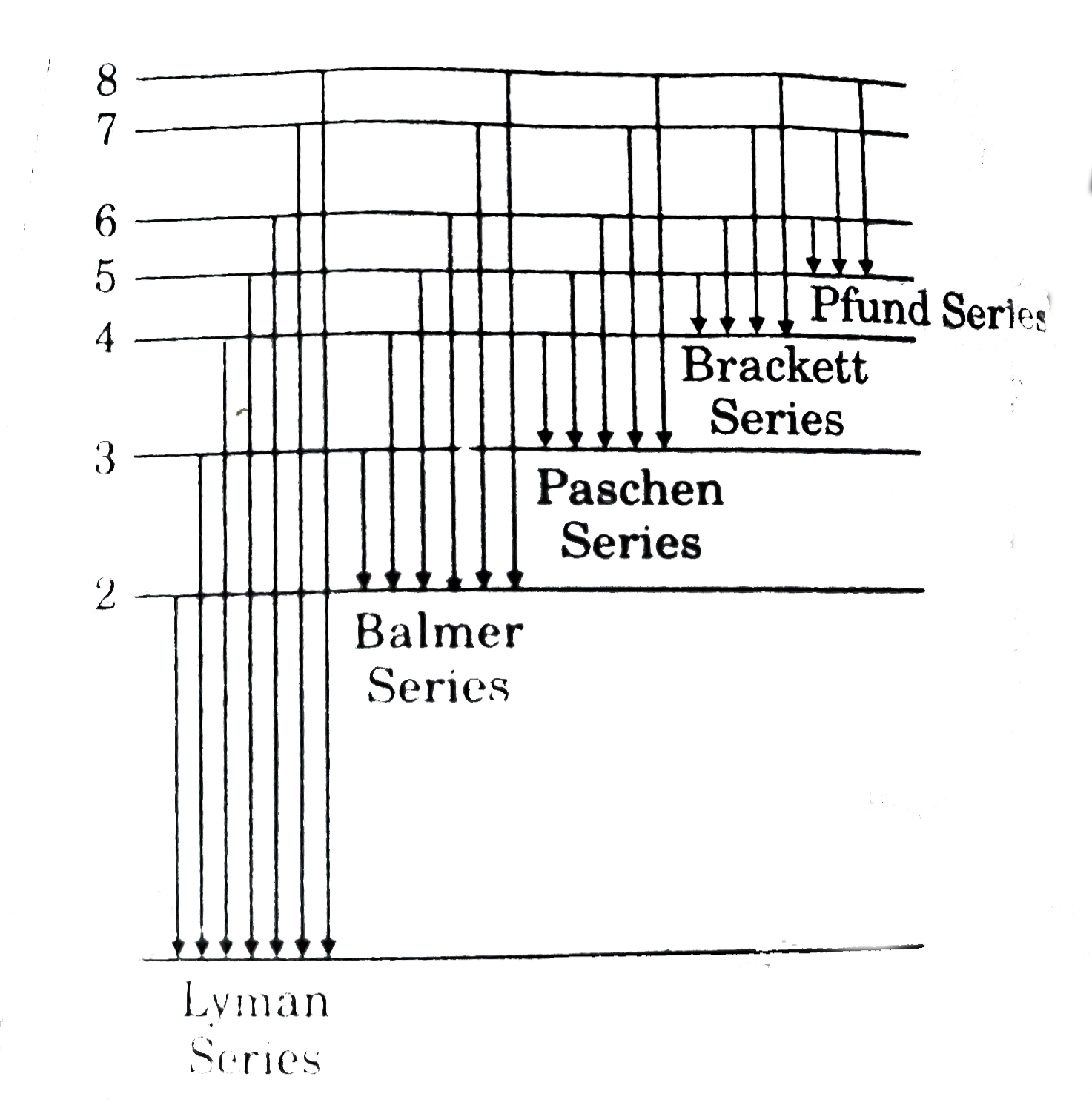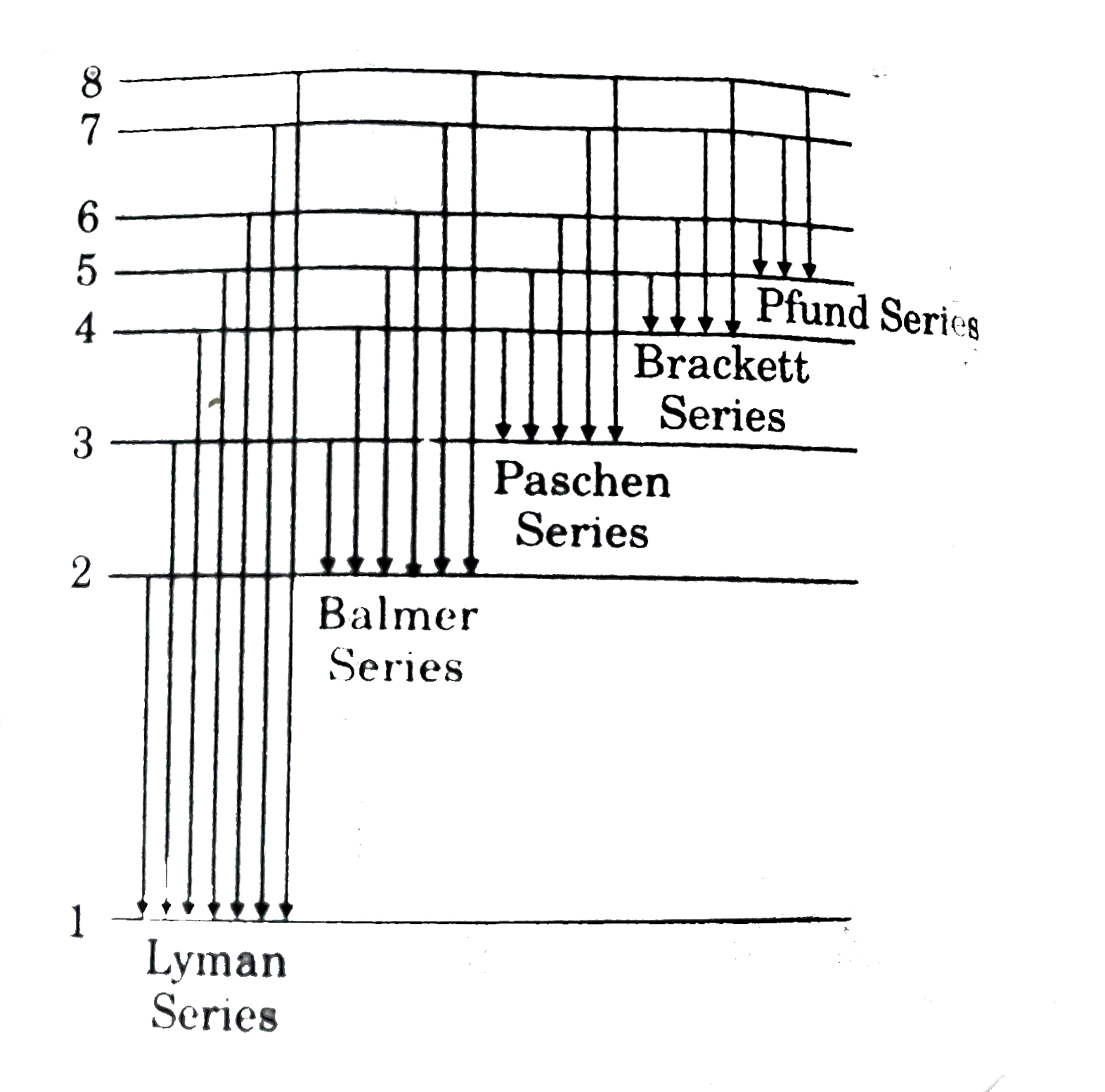In hydrogen spectrum wave number of different lines is given by 1λ=RH⎡⎣1n2i−1n2f⎤⎦ where RH=1.090678×107m−1 The wavelength of first line of Lyman series would be
122×10−7m
9.1176×10−8m
12.2×10−7m
1.22×10−7m
The correct Answer is:D
For first line in Lyman series
ni=1,nf=2
Topper's Solved these Questions
Similar Questions
When electron jumps from higher orbit to lower orbit, then energy is radiated in the form of electromagnetic radiation and these radiations are used to record the emission spectrum Energy of electron may be calculated as
E=−2π2meZ2e4n2h2
Where, me= rest mass of electron
ΔE=(En2−En1)=13.6×Z2[1n21−1n22]eV per atom
This equation was also used by Rydberg to calculate the wave number of a particular line in the spectrum
¯v=1λ=RHZ2[1n21−1n22]m−1
Where RH=1.1×107m−1 (Rydberg constant)
For Lyman, Balmer, Paschen, Brackett and Pfund series the value of n1=1,2,3,4,5 respectively and n2=∞ for series limit. If an electron jumps from higher orbit n to ground state, then number of spectral line will be .nC2. Ritz modified the Rydberg equation by replacing the rest mass of electron with reduced mass (μ).
1μ=1mN+1me
Here, mN= mass of nucleus me= mass of electron Answer the following questions
If the wavelength of series limit of Lyman's series of He+ ions is ''a'' 0A, then what will be the wavelength of series limit of Lyman's series for Li2+ ion?View SolutionWhen electron jumps from higher orbit to lower orbit, then energy is radiated in the form of electromagnetic radiation and these radiations are used to record the emission spectrum Energy of electron may be calculated as
E=−2π2meZ2e4n2h2
Where, me= rest mass of electron
ΔE=(En2−En1)=13.6×Z2[1n21−1n22]eV per atom
This equation was also used by Rydberg to calculate the wave number of a particular line in the spectrum
¯v=1λ=RHZ2[1n21−1n22]m−1
Where RH=1.1×107m−1 (Rydberg constant)
For Lyman, Balmer, Paschen, Brackett and Pfund series the value of n1=1,2,3,4,5 respectively and n2=∞ for series limit. If an electron jumps from higher orbit n to ground state, then number of spectral line will be .nC2. Ritz modified the Rydberg equation by replacing the rest mass of electron with reduced mass (μ).
1μ=1mN+1me
Here, mN= mass of nucleus me= mass of electron Answer the following questions
The emission spectrum of He+ involves transition of electron from n2→n1 such that n2+n1=8 and n2−n1=4. what whill be the total number of lines in the spectrum?View Solution
Knowledge Check
- Question 1 - Select One
the only electron in the hydrogen atom resides under ordinary conditions in the first orbit. When energy is supplied the electron moves to higher energy orbit depending on the amount of energy absorbed. It emits energy. Lyman series is formed when the electron returns to the lowest orbit while Balmer series is formed when the electron returns to second. Similarly, Paschen, Breakett and Pfund series are formed when electron returns to the third, fourth and fifth orbits from higher energy orbits respectively (as shown in figure).

Maximum number of different lines produced when electron jump from nth level to ground level is equal to
n(n−1)2.
For example in the case of n=4, number of lines produced is 6.(4→3,4→2,4→1,3→2,3→1,2→1).When an electron returns from n2ton1 state, the number of different
lines in the spectrum will be equal to (n2−n1)(n2−n1+1)2
If the electron comes back from energy level having energy E2 to energy level having energy E1, then the difference may be expressed in terms of energy of photon as:
E2−E1=ΔE,λ=hcΔE,ΔE=hv(v−frequency)
Since h and c are constants ΔE corresponds to definite energy: thus each transition from one energy level to another will produce a light of definite wavelength. This is actually observed as a line in the spectrum of hydrogen atom.
Wave number of line is given by the formula:
¯v=RZ2(1n21−1n22)
where R is a Rydberg constant (R=1.1×107m−1).
(i) First line of a series : It is called line of longest wavelength of line of smallest energy'.
(ii) Series limit or last line of a series : It is the line of shortest wavelength or line of highest energy.
Last line of breakett series for H-atom has wavelength λ1Å and 2nd line of Lyman series has wavelength λ2Åthen:A128λ1=9λ2B16λ1=9λ2C4λ1=1λ2D128λ1=1λ2 - Question 2 - Select One
the only electron in the hydrogen atom resides under ordinary conditions in the first orbit. When energy is supplied the electron moves to higher energy orbit depending on the amount of energy absorbed. It emits energy. Lyman series is formed when the electron returns to the lowest orbit while Balmer series is formed when the electron returns to second. Similarly, Paschen, Breakett and Pfund series are formed when electron returns to the third, fourth and fifth orbits from higher energy orbits respectively (as shown in figure).

Maximum number of different lines produced when electron jump from nth level to ground level is equal to
n(n−1)2.
For example in the case of n=4, number of lines produced is 6.(4→3,4→2,4→1,3→2,3→1,2→1).When an electron returns from n2ton1 state, the number of different
lines in the spectrum will be equal to (n2−n1)(n2−n1+1)2
If the electron comes back from energy level having energy E2 to energy level having energy E1, then the difference may be expressed in terms of energy of photon as:
E2−E1=ΔE,λ=hcΔE,ΔE=hv(v−frequency)
Since h and c are constants ΔE corresponds to definite energy: thus each transition from one energy level to another will produce a light of definite wavelength. This is actually observed as a line in the spectrum of hydrogen atom.
Wave number of line is given by the formula:
¯v=RZ2(1n21−1n22)
where R is a Rydberg constant (R=1.1×107m−1).
(i) First line of a series : It is called line of longest wavelength of line of smallest energy'.
(ii) Series limit or last line of a series : It is the line of shortest wavelength or line of highest energy.
wave number of the first line of Paschen series in Be3+ ion is :A7R16B7R144C7R9DR144 - Question 3 - Select One
the only electron in the hydrogen atom resides under ordinary conditions in the first orbit. When energy is supplied the electron moves to higher energy orbit depending on the amount of energy absorbed. It emits energy. Lyman series is formed when the electron returns to the lowest orbit while Balmer series is formed when the electron returns to second. Similarly, Paschen, Breakett and Pfund series are formed when electron returns to the third, fourth and fifth orbits from higher energy orbits respectively (as shown in figure).

Maximum number of different lines produced when electron jump from nth level to ground level is equal to
n(n−1)2.
For example in the case of n=4, number of lines produced is 6.(4→3,4→2,4→1,3→2,3→1,2→1).When an electron returns from n2ton1 state, the number of different
lines in the spectrum will be equal to (n2−n1)(n2−n1+1)2
If the electron comes back from energy level having energy E2 to energy level having energy E1, then the difference may be expressed in terms of energy of photon as:
E2−E1=ΔE,λ=hcΔE,ΔE=hv(v−frequency)
Since h and c are constants ΔE corresponds to definite energy: thus each transition from one energy level to another will produce a light of definite wavelength. This is actually observed as a line in the spectrum of hydrogen atom.
Wave number of line is given by the formula:
¯v=RZ2(1n21−1n22)
where R is a Rydberg constant (R=1.1×107m−1).
(i) First line of a series : It is called line of longest wavelength of line of smallest energy'.
(ii) Series limit or last line of a series : It is the line of shortest wavelength or line of highest energy.
Consider the following statements
(i) Spectral lines of He+ion belonging to Balmer series are not in visible range.
(ii) In the Balmer series of H-atom maximum lines are in ultraviolet ragion.
(iii) 2nd line of Lyman series of He+ ion has energy 48.35eV
The above statement (i), (ii), (iii) respectively are(T=True,F=False):ATFFBFTTCTFTDTTT
When electron jumps from higher orbit to lower orbit, then energy is radiated in the form of electromagnetic radiation and these radiations are used to record the emission spectrum Energy of electron may be calculated as
E=−2π2meZ2e4n2h2
Where, me= rest mass of electron
ΔE=(En2−En1)=13.6×Z2[1n21−1n22]eV per atom
This equation was also used by Rydberg to calculate the wave number of a particular line in the spectrum
¯v=1λ=RHZ2[1n21−1n22]m−1
Where RH=1.1×107m−1 (Rydberg constant)
For Lyman, Balmer, Paschen, Brackett and Pfund series the value of n1=1,2,3,4,5 respectively and n2=∞ for series limit. If an electron jumps from higher orbit n to ground state, then number of spectral line will be .nC2. Ritz modified the Rydberg equation by replacing the rest mass of electron with reduced mass (μ).
1μ=1mN+1me
Here, mN= mass of nucleus me= mass of electron Answer the following questions
The ratio of the wavelength of the first line to that of second line of Paschen series of H-atom isView SolutionFor balmer series in the spectrum of atomic hydrogen the wave number of each line is given by
¯¯¯V=RH1n21−1n22 where RH is a constant and n1 and n2 are integers which of the following statement (S) is / are correct
1 as wavelength decreases the lines in the series converge
2 The integer n1 is equal to 2
3 The ionization energy of hydrogen can be calculated from the wave number of these lines
4 The line of longest wavelength corresponds to n2=3View SolutionThe only electron in the hydrogen atom resides under ordinary conditions on the first orbit. When energy is supplied, the electron moves to higher energy orbit depending on the amount of energy absorbed. When this electron returns to any of the lower orbits, it emits energy. Lyman series is formed when the electron returns to the lowest orbit while Balmer series is formed when the electron returns to second orbit. Similarly, Paschen, Brackett and Pfund series are formed when electron returns to the third, fourth and fifth orbits from higher energy orbits respectively.
Maximum number of lines produced when an electron jumps from nth level to ground level is equal to n(n−1)2. For exampe, in the case of n=4, number of lines produced is 6(4→3,4t2,4→1,3→2,3→1,2→1). When an electron returns from n2 and n1 state, the number of lines in the spectrum will be equal to
(n2−n1)(n2−n1+12
If the electron comes back from energy level having energy E2 to energy level having energy E1, then the difference may be expressed in terms of energy of photon as :
E2−E1=ΔE,λ=hcΔE
Since h and c are constants, ΔE corresponds to definite energy, thus each transition from one energy level to another will produce a light of definitewavelength. This is actually observed as a line in the spectrum of hydrogen atom.
Wave number of line is given by the formula
→v=R(1n21−1n22), where R is a Rydberg's constant (R=1.1×107m−1)
The difference in the wavelength of the 1st line of Lyman series and 2nd line of Balmer series in a hydrogen atom is :View SolutionFor balmer series in the spectrum of atomic hydrogen the wave number of each line is given by ¯¯¯V=R[1n21−1n22] where RH is a constant and n1 and n2 are integers. Which of the following statements (s), is (are correct)
1. As wave length decreases the lines in the series converge
2. The integer n1 is equal to 2.
3. The ionisation energy of hydrogen can be calculated from the wave numbers of three lines.
4. The line of shortest wavelength corresponds to = 3.View SolutionFor balmer series in the spectrum of atomic hydrogen the wave number of each line is given by ¯¯¯V=R[1n21−1n22] where RH is a constant and n1 and n2 are integers. Which of the following statements (s), is (are correct)
1. As wave length decreases the lines in the series converge
2. The integer n1 is equal to 2.
3. The ionisation energy of hydrogen can be calculated from the wave numbers of three lines.
4. The line of shortest wavelength corresponds to = 3.View Solution

